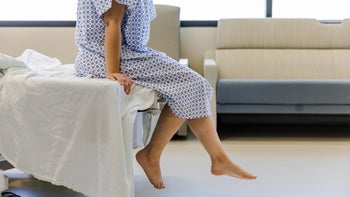
7 Estradiol (Estrace) Vaginal Cream Side Effects You Should Know About
Key takeaways:
Estradiol (Estrace) vaginal cream relieves vaginal symptoms of menopause. It’s generally well tolerated and has fewer risks and side effects than oral estradiol. That’s because it works locally in the vaginal area and isn’t well absorbed into the bloodstream.
Common estradiol vaginal cream side effects include vaginal burning or irritation, headache, and sore breasts. Nausea and vaginal infections are also possible.
In rare cases, estradiol vaginal cream may cause vaginal bleeding or spotting. Let your prescriber know if this occurs, as it could be a sign of a more serious issue. Estradiol vaginal cream doesn’t seem to cause an increased risk of heart-related side effects, or breast or endometrial cancer. These side effects are mainly associated with other forms of estradiol that are absorbed into the bloodstream.
Table of contents

Estradiol (Estrace) vaginal cream contains a lab-made form of estrogen. It works locally in the vagina to relieve vaginal symptoms of menopause, such as burning, irritation, and dryness.
Estradiol vaginal cream isn’t absorbed into your bloodstream like some other forms of estradiol, such as a pill or patch. So it typically causes fewer bodywide side effects. But there are still some side effects to be aware of while you’re using it.
Estradiol vaginal cream side effects at a glance
Below is a list of common and rare estradiol vaginal cream side effects. Keep in mind that this list also includes side effects reported with oral estradiol. They aren’t as likely with vaginal estradiol, but they can still happen in rare cases.
Search and compare options
Mild side effects of estradiol vaginal cream include:
Vaginal burning or irritation
Headache
Vaginal discharge or spotting
Enlarged or tender breasts
Stomach cramps
Bloating
Excess fluid
Vaginal infections
Nausea
Hair loss
Rare but serious estradiol vaginal cream side effects include:
Unusual vaginal bleeding
High blood pressure
High calcium levels
Vision changes
High triglyceride levels
Increased risk of gallbladder disease
This medication also has a few boxed warnings, the FDA’s strictest warning for medications. These warnings are required on all estrogen-based medications used as part of hormone replacement therapy (HRT). But they’re not associated with most vaginal forms of estrogen.
Increased risk of breast and endometrial cancer
Increased risk of blood clots, stroke, and heart attack
Increased risk of dementia
Let’s take a closer look at seven estradiol vaginal cream side effects.
1. Vaginal burning or irritation
Vaginal burning, itching, and irritation (vaginitis) are common side effects reported by those using estradiol vaginal cream. These symptoms may go away on their own as your body adjusts to the medication and your vaginal dryness improves.
Sometimes, vaginal burning or irritation is caused by the applicator, not the cream itself. If you find the applicator uncomfortable or painful to use, talk to your prescriber about using your finger instead. There are also other vaginal dosage forms, such as rings or tablets, that may be more comfortable for you.
Douching and wearing tight pants can worsen vaginal irritation. It’s best to avoid these things whenever possible. If you notice an odor, change in discharge, or blood along with vaginal irritation, seek medical care — these may be a sign of infection. Vaginal infections are also a possible estradiol vaginal cream side effect. Your prescriber can determine what type of infection you have and the best course of treatment.
Good to know: Some estradiol vaginal cream may leak out after insertion. This is normal and doesn’t affect how well the medication works. But it can be easy to confuse this with vaginal discharge. So keep an eye out for a change in the consistency, color, or odor of your discharge to help you determine if a vaginal infection could be an issue. And ask a healthcare professional if you’re unsure.
2. Headache
You may experience a headache while using estradiol vaginal cream. Headaches can occur when there are changes in your hormone levels. But they also have many other causes.
Vaginal dryness? Learn which over-the-counter and prescription treatments work best.
Hormone treatment for perimenopause: Here are the risks and benefits of hormone treatment for perimenopause symptoms.
Estrogen supplements guide: From patches and pills to vaginal creams and rings, we cover the different types of estrogen supplements and how they compare.
Make sure you’re eating regularly and drinking enough fluids. Good sleep habits can also help keep headaches at bay. If needed, try an over-the-counter (OTC) pain reliever, such as acetaminophen (Tylenol) or ibuprofen (Motrin, Advil). But check with your healthcare team first, as these medications aren’t recommended for everyone.
If you experience a sudden, severe headache or have a headache along with vision changes or weakness on one side of your body, seek medical care right away. These may be signs of something more serious, such as a stroke.
3. Sore breasts
Estradiol vaginal cream may cause breast pain for some people. This side effect is more likely with oral estradiol, but it’s possible with the vaginal cream, as well.
A cold or warm compress may help lessen breast pain. An OTC pain reliever may also help if your prescriber OKs it. But if you notice any discharge from your nipple or changes in how your breasts look or feel, be sure to let your healthcare team know right away. These could be signs of something more serious, such as breast cancer.
4. Nausea
Estradiol vaginal cream may cause mild nausea, along with stomach cramps and bloating. These aren’t common side effects, but they can be bothersome. Try using your estradiol vaginal cream at night — these symptoms may be less of an issue while you’re asleep.
An OTC medication such as bismuth subsalicylate (Pepto-Bismol) or simethicone (Gas-X) may help with bloating and cramping. But if your stomach-related symptoms persist or worsen, it’s a good idea to let your prescriber know. They can help determine what’s causing them and the best steps for you to take.
5. Vaginal bleeding
Irregular vaginal bleeding or spotting is a possible side effect of estradiol vaginal cream. It’s a good idea to use a pantyliner to protect your clothing while you’re using it (this can protect your clothes from cream leakage, as well).
In most cases, this side effect is mild and not a concerning issue. But unexplained vaginal bleeding after menopause may be a sign of something more serious. So it’s a good idea to discuss any bleeding or spotting that occurs with your prescriber to be safe.
6. Increased risk of heart attack, stroke, and blood clots
A nationwide study known as the Women’s Health Initiative (WHI) found that postmenopausal women taking oral HRT had a high risk of heart-related side effects. But newer studies show that this risk is much lower if you are age 60 or younger and start HRT within 10 years of starting menopause. What’s more, vaginal forms of estrogen aren’t absorbed well into the bloodstream. So the risk of these side effects from vaginal estradiol cream is even lower.
That being said, it’s helpful to be aware of the symptoms of a heart attack, stroke, or blood clot. Call 911 or seek emergency care if you experience:
Trouble breathing, chest pain, or pain and swelling that’s warm to the touch in one leg (blood clot symptoms)
Weakness or numbness on one side of your body, vision changes, or severe headache (stroke symptoms)
Chest pain or pressure that spreads to your arms, neck or jaw, trouble breathing, and sweating (heart attack symptoms). Women are more likely to have symptoms that include heart palpitations and fatigue.
7. Increased risk of certain cancers
Similar to the risk of heart-related issues, there’s an increased risk of certain cancers associated with oral HRT. These include breast cancer and endometrial cancer. But it’s widely accepted among medical professionals that vaginal estradiol treatments don’t carry this risk.
If you have a history of breast or uterine cancer, talk to your healthcare team about whether vaginal estradiol cream is a safe option for you. Even if you don’t have a history of these conditions, be sure to perform monthly breast self-examinations and report any bumps or lumps to a healthcare professional. And don’t forget to schedule a yearly mammogram, too.
Signs of endometrial cancer include pelvic pain and unexplained vaginal bleeding. Be sure to report these symptoms to your healthcare team if they occur.
Does estradiol vaginal cream help with sexual arousal?
Possibly. Vaginal symptoms of menopause can make sex painful or uncomfortable, which may affect your sexual arousal. Vaginal estradiol cream can help relieve these symptoms, which may make sex more comfortable and enjoyable and improve your overall sexual arousal.
Does estradiol vaginal cream cause weight gain?
No. Vaginal estradiol cream, and HRT in general, haven’t been associated with weight gain. But weight changes are common during menopause. So you may need to modify your diet and exercise habits to adjust to your changing body. Talk to your healthcare team about any weight-related concerns for guidance.
The bottom line
Estradiol vaginal cream (Estrace) treats vaginal symptoms associated with menopause. Common estradiol vaginal cream side effects include vaginal irritation, sore breasts, and headaches. Nausea and vaginal infections are also possible. Estradiol vaginal cream may cause vaginal bleeding or spotting. In rare cases, this may be a sign of a more serious issue, so let your prescriber know if it occurs.
There’s an increased risk of heart-related issues and certain cancers for some people taking oral estradiol medication. But these risks aren’t associated with estradiol vaginal cream. Talk to your healthcare team about any side effects that are bothersome. And seek emergency care if any life-threatening symptoms appear.
Why trust our experts?



References
Bhupathiraju, S. N., et al. (2018). Vaginal estrogen use and chronic disease risk in the Nurses’ Health Study. Menopause.
Constantine, G. D., et al. (2019). Endometrial safety of low-dose vaginal estrogens in menopausal women: A systematic evidence review. Menopause.
DePolo, J., et al. (2024). Using HRT (hormone replacement therapy). Breastcancer.org.
Hosseinzadeh. P., et al. (2015). A comparative study of vaginal estrogen cream and sustained-release estradiol vaginal tablet (Vagifem) in the treatment of atrophic vaginitis in Isfahan, Iran in 2010-2012. Journal of Research in Medical Sciences.
Lynch, C. (2009). Vaginal estrogen therapy for the treatment of atrophic vaginitis. Journal of Women’s Health.
Manson, J. E., et al. (2013). The women’s health initiative hormone therapy trials: Update and overview of health outcomes during the intervention and post-stopping phases. JAMA.
MedlinePlus. (2022). Breast pain.
National Institute on Aging. (2021). Sex and menopause: Treatment for symptoms.
Prasco Laboratories. (2023). Estradiol vaginal cream- estradiol cream [package insert].
The American College of Obstetricians and Gynecologists. (2024). Perimenopausal bleeding and bleeding after menopause.
The Menopause Society. (n.d.). Menopause topics: Hormone therapy.
Was this page helpful?
Related Articles
Browse medications
View AllResearch prescriptions and over-the-counter medications from A to Z, compare drug prices, and start saving.


























